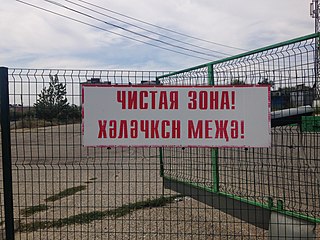
The Russian alphabet is the script used to write the Russian language. It comes from the Cyrillic script, which was devised in the 9th century for the first Slavic literary language, Old Slavonic. Initially an old variant of the Bulgarian alphabet, it became used in the Kievan Rusʹ since the 10th century to write what would become the modern Russian language.

Kalmyk Oirat, commonly known as the Kalmyk language, is a variety of the Oirat language, natively spoken by the Kalmyk people of Kalmykia, a federal subject of Russia. In Russia, it is the standard form of the Oirat language, which belongs to the Mongolic language family. The Kalmyk people of the Northwest Caspian Sea of Russia claim descent from the Oirats from Eurasia, who have also historically settled in Mongolia and Northwest China. According to UNESCO, the language is "Definitely endangered". According to the Russian census of 2010, there are 80,500 speakers of an ethnic population consisting of 183,000 people.
Oleg Nikolayevich Trubachyov was a Soviet and Russian linguist. A researcher of the etymology of Slavic languages and Slavic onomastics, specialist in historical linguistics and lexicographer. He was a Doctor of Sciences in Philological Sciences, an academician of the Russian Academy of Sciences and served as the editor-in-chief of the Etimologiya yearbook. His works are on the etymology of Slavic languages and on East Slavic onomastics.

There are 4 stages in the history of Yakut writing systems:

Iosif Antonovich Goshkevich was a Russian diplomat and Orientalist of Belarusian descent. He graduated from the Saint Petersburg Theological Academy in 1839 and served in the Russian clerical legation in Beijing from 1839 to 1848. From 1853 to 1855, he worked as an interpreter for the Chinese language in Yefim Putyatin's embassy in Japan. Goshkevich then served in Asiatic department of Russian MFA from 1856 to 1858. Along with a Japanese co-author, Goshkevich compiled the first Japanese-Russian dictionary, which was published in Saint Petersburg in 1857. Goshkevich also became the first Russian diplomatic representative in Japan, serving from 1858 to 1865. He wrote several works about China, Japan and the peculiarities of Japanese and Chinese languages.

The Etymological Dictionary of Slavic Languages: Proto-Slavic Lexical Stock is an etymological dictionary of the reconstructed Proto-Slavic lexicon. It has been continuously published since 1974 until present, in 43 volumes, making it one of the most comprehensive in the world.

The Kórmchaia Book, also known as the Books of the Pilot (Russian: Ко́рмчая книга, Ко́рмчая from кормчий, Church Slavonic: кръмьчии 'helmsman, ship's pilot'; Pidalion or Nomocanon, are collections of church and secular law, which constituted guide books for the management of the church and for the church court of Orthodox Slavic countries and were also the transmission of several older texts. They were written in Old Church Slavonic and Old East Slavic.

Tatiana Valerianovna Dorofeeva was a Russian linguist, orientalist and translator.
Nikolai Vasilyevich Rumyantsev was a Soviet author of several polemics on the history of Christianity, translator. He was also a member of the Soviet circle "Atheist" and the League of Militant Atheists. In the 1920s Rumyantsev was one of the leading proponents of the so-called mythological school in the Soviet academia. He authored such publications, as "The Pre-Christian Christ", "The Pagan Christs – the Ancient Precursors of Christianity", "The Apocalypse – The Revelation of John" and "Orthodox Holidays, Their Origin and Class Essence" (1936). "The Apocalypse – The Revelation of John" was published under the influence of Abram Ranovich. In that publication Rumyantsev, while not explicitly retracting his earlier opinions, offered a study of early Christianity which stressed not its derivation from supposed ancient mythology, but its intrinsic relation to revolutionary, messianic elements in contemporary Judaism.
Vladimir Semionovich Spirin was a Russian philologist, sinologist, historian, lecturer of Saint Petersburg State University, researcher at Saint Petersburg's branch of the Institute of Oriental Studies of the Russian Academy of Sciences, Saint Petersburg Russia, Candidate of Sciences. His primary scientific interests resided in the field of classical Chinese philology and Chinese philosophy.
Vitaliy Alekseevich Shishakov, was a Russian popularizer of scientific knowledge, journalist, candidate of pedagogical sciences, and an honorary member of the All-Union Astronomical and Geodetic Society (1965).
Ivan Aleksandrovich Flerov was a Soviet educationist, journalist, and writer on problems of religion and atheism.
Klara Naumovna Berkova, was a Russian writer, doctor of medicine, popularizer of scientific and anti-religious knowledge.

Vladimir Kapitonovich Nikolsky was a Soviet historian, ethnologist, translator, religious scholar, Doctor of Historical Sciences (1943), and professor.
The Komi language, a Uralic language spoken in the north-eastern part of European Russia, has been written in several different alphabets. Currently, Komi writing uses letters from the Cyrillic script. There have been five distinct stages in the history of Komi writing:

Vladimir Konstantinovich Soldatov was a Russian and Soviet ichthyologist, zoologist, Doctor of Biological Sciences, professor of the Department of Ichthyology of the Moscow Technical Institute for the Fishery Industry.
Since its inception in the 18th century and up to the present, it is based on the Cyrillic alphabet to write the Udmurt language. Attempts were also made to use the Latin alphabet to write the Udmurt language. In its modern form, the Udmurt alphabet was approved in 1937.
Evenki orthgraphy is the orthography of the Evenki language.

The Word of a certain Christ-lover and zealot for the right faith is a significant work of ecclesiastical Old East Slavic literature. It is an Orthodox work directed against folk customs and pagan beliefs and rituals.
Khakass alphabets are the alphabets used to write the Khakas language.










